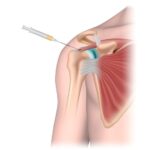Frozen Shoulder
One of the most common forms of shoulder pain is an ailment known as Adhesive Capsulitis or commonly referred to as, “frozen shoulder.” Frozen shoulder causes stiffness and pain in the shoulder joint and can lead to a loss of movement completely.
However, unlike more well-known conditions – such as shoulder arthritis, impingement, and rotator cuff injuries — it is often not identified as the source of someone’s discomfort until symptoms have become more severe.
This is why it’s important to know about the condition and recognize symptoms for early diagnosis and treatment.
Typically, there are three stages of frozen shoulder.
- The first stage starts with an individual noticing limited movement within the shoulder joint. It causes severe pain and inflammation as well.
- In the second stage, the fluid around the joint begins to thicken and movement becomes even more restricted. Sometimes during this stage shoulder pain can subside, but the movement is more severely restricted.
- The final stage of frozen shoulder is when the shoulder starts to recover. The inflammation decreases and movement starts to return, although it may never be back to the full movement. Sometimes the whole process of recovery from a frozen shoulder can last up to 3 years.
People 40 and older, particularly women, are more likely to have frozen shoulder, as well as people who’ve had prolonged immobility or reduced mobility of the shoulder. Your risk of developing frozen shoulder increases if you’re recovering from a medical condition or procedure that prevents you from moving your arm.
Frozen shoulder, like any loss of mobility, is scary. The good news, though, is that early treatment will dramatically reduce the onset of severe stiffness and pain.
If you are experiencing any pain or feel that you are showing the signs of a frozen shoulder, make an appointment to see your experienced care team at Ohio Healthcare Partners today!
If your shoulder pain is caused by a work-related injury, Ohio Healthcare Partners is an Ohio Bureau of Workers’ Compensation certified provider.
Non-Surgical Treatment Options for Shoulders at Ohio Healthcare Partners
Joint Injections
When joint pain does not resolve in a reasonable amount of time with OTC medication and/or physical therapy, an injection of medication directly into the joint is a frequently performed procedure.
What is in a joint injection?
 A joint injection typically contains a local anesthetic and a corticosteroid. The local anesthetic, similar to what you might receive at the dentist, provides early pain relief, while the steroid suppresses inflammation and decreases swelling for long-term pain relief.
A joint injection typically contains a local anesthetic and a corticosteroid. The local anesthetic, similar to what you might receive at the dentist, provides early pain relief, while the steroid suppresses inflammation and decreases swelling for long-term pain relief.
In addition to treating joint pain, injections are used as a diagnostic tool. The local anesthetic has a numbing effect on the joint, and the amount of immediate pain relief experienced will help confirm or rule out the joint as a source of pain.
How are shoulder joint injections administered?
A joint injection is used to treat inflammatory joint conditions such as arthritis, gout, bursitis, tendonitis, and osteoarthritis.
The injection is performed by using ultrasound to guide exactly where the needle needs to go into the affected joint and distributing an anti-inflammatory agent. The most common of these is a corticosteroid (cortisone shots).
What can be expected after a shoulder joint injection?
After the injection, you may experience immediate but temporary pain relief from the local anesthetic.
Because steroids need a few days to deliver noticeable benefits, there is a chance of the pain returning or even worsening. If the pain worsens, it usually subsides within a day or two.
Generally, it’s recommended that you take it easy the day of the procedure, but return to your usual activities the following day. You can ice down the injection site and take an over-the-counter NSAID, like ibuprofen, for pain relief.
Although joint injections do not change the underlying condition, they can break the cycle of pain and inflammation and allow time for exercise or physical therapy to strengthen muscles and get the joints moving again in order to decrease ongoing problems.
We combine all of our shoulder therapy treatment plans with a combination of comprehensive therapeutic exercises, chiropractic care, and medical massage to achieve maximum results with our program!
To learn more about our Comprehensive Shoulder Treatment Options, contact our team at Ohio Healthcare Partners in Akron, Ohio.



